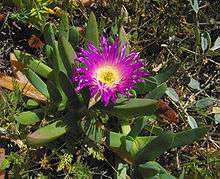Carpobrotus chilensis
| Carpobrotus chilensis | |
|---|---|
 | |
| Scientific classification | |
| Kingdom: | Plantae |
| (unranked): | Angiosperms |
| (unranked): | Eudicots |
| (unranked): | Core eudicots |
| Order: | Caryophyllales |
| Family: | Aizoaceae |
| Genus: | Carpobrotus |
| Species: | C. chilensis |
| Binomial name | |
| Carpobrotus chilensis (Molina) N.E. Br | |
| Synonyms | |
|
Mesembryanthemum chilense | |
Carpobrotus chilensis is a species of succulent plant known by the common name sea fig.
It is probably native to southern Africa. It is familiar elsewhere, particularly the coastline of western North America, where it is an introduced invasive species that has taken hold and become commonplace. It is also found in parts of South America.
Description
Carpobrotus chilensis has long stems and fleshy, pointed leaves which are triangular in cross-section. Its flowers are magenta and are smaller than those of ice plant.
- Invasive species
It is similar to, and often mistaken for, its close relative "ice plant" (Carpobrotus edulis) which grows alongside and sometimes hybridizes with it. Like ice plant, this species is hardy and can withstand disturbance by humans, which is common on the well-traveled beaches where it grows. This trait gives it an advantage over many native plant species, causing it to become a threat to native coastal ecosystems where it has invaded.
External links
- Jepson Manual Treatment — Carpobrotus chilensis
- USDA Plants Profile: Carpobrotus chilensis
- Carpobrotus chilensis — U.C. Photo gallery
| Wikimedia Commons has media related to Carpobrotus chilensis. |